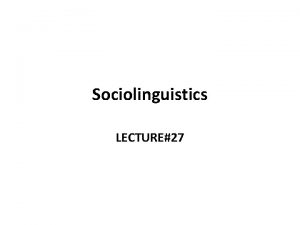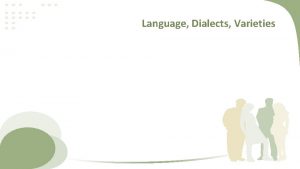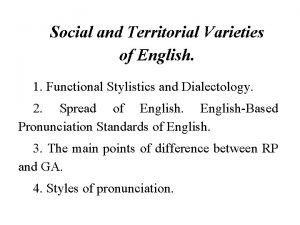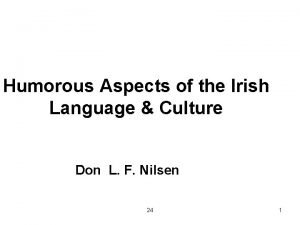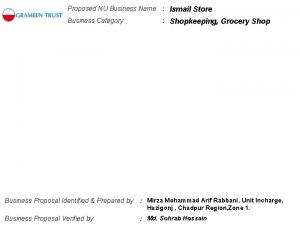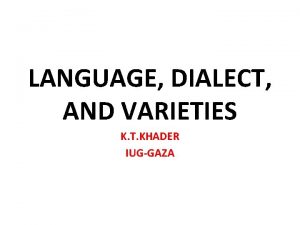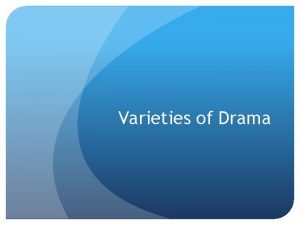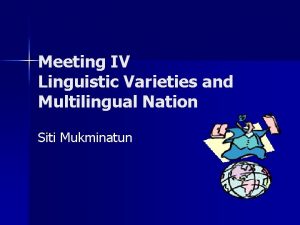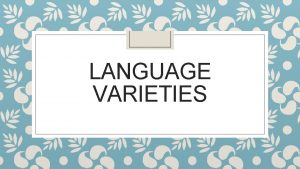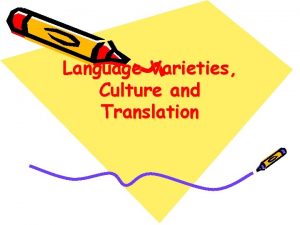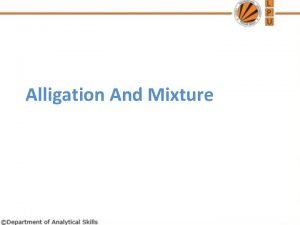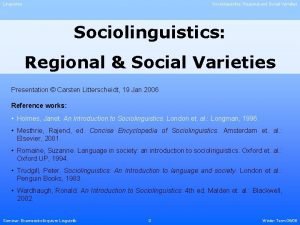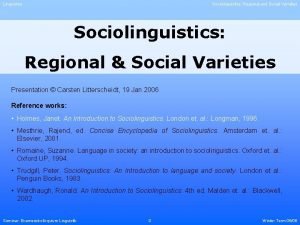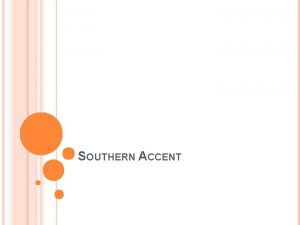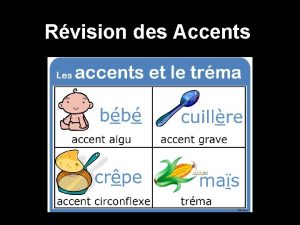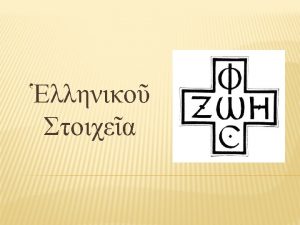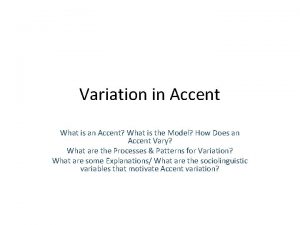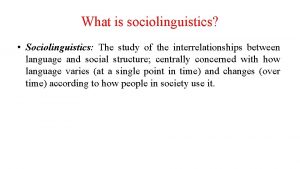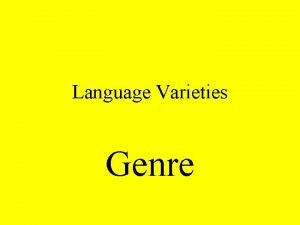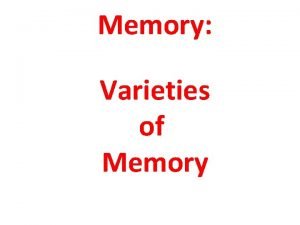Varieties of English Sociolinguistics Sociolinguistics Study of accent
















- Slides: 16

Varieties of English Sociolinguistics

Sociolinguistics • Study of accent and dialect is part of sociolinguistics • Mostly so far we have looked purely descriptively at accents/dialects • Clearly just below the surface is the fact that varieties of language are connected in some way to sociological issues • We will look at these issues for the next few sessions 2

Language and dialect • We prefer to think – Languages have various dialects. – There actually a range of varieties that people consider to be standard. – What is considered standard is associated with prestige, a nonlinguistic factor. – From a linguistic standpoint, what is considered standard has NOTHING to do with correctness or superiority. – From a linguistic standpoint, ALL DIALECTS are equally correct, equally expressive, equally complex, equally logical and so forth. That is, the term non-standard dialect means just that, not the standard dialect. It DOES NOT MEAN inferior or sub-standard. – Non-standard dialects are not simply offshoots from the standard. In fact, often the opposite is true 3

Language and dialect • Some common misconceptions – A language is composed of a "standard" dialect from which all of the other non-standard dialects emerge. – The standard dialect is the "correct" way to speak the language. – The other dialects represent erroneous or inferior ways of speaking the language. – The standard language is more complex, more logical, more expressive than the non-standard dialects. – Non-standard dialects are a product of "lazy" speech. 4

Factors in classifying dialects • Geography – Dialectology – Effects still surprisingly strong despite global communications and mobility • Ethnicity – Often closely tied to geography – Various features associated with certain ethnic groups cut across geographical boundaries – Self identity often an important effect here • Social class – Socio-economic factors – Class consciousness, identity and aspirations 5

History of Sociolinguistics • Usually said to start with Labov (1966), but actually dates back to 1900 s • Saussure’s langue~parole distinction reflects difference between abstract and “language in use” • Dialect geographers of the 1930 s commented on social aspects of dialect differences • At the same time, anthropological linguists couldn’t help but note socially conditioned aspects of “exotic” languages • Also, researches interested in bilingualism (1930 s) noted a sociological aspect 6

History of Sociolinguistics • 1960 s/1970 s saw much work in – Language and social context (Hymes, Fishman) – Language and class (Labov, Bernstein) – Language and gender (Lakoff) – Issue of dialect vs language (status) – Pidgins and creoles – Bilingualism, code shifting 7

History of Sociolinguistics • Focus in late 1970 s/1980 s reflects contemporary social issues – Studies of Black English (Ebonics, and other names) • emphasize linguistic integrity of nonstandard forms • link between language and identity • similarities across regions, plus certain features suggest it may be a creole rather than a (number of) dialect(s) – Language and gender • How language reveals, embodies and sustains attitudes to gender. • How language users speak or write in (different and distinctive) ways that reflect their sex • Latterly, including gay and lesbian issues – Language and politics • All of the above, plus: How language reveals, embodies and sustains attitudes to political positions (eg marxist, colonialist, …) 8

Fundamental concepts • • • Speech community Prestige Internal vs external language Class Age Gender 9

Speech community • Group of people who share some identifiable aspect of their linguistic communication • More importantly: there should be some self identification as a community … • and there may be some degree of deliberate exclusion of outsiders • Speech communities can be defined by geography, ethnicity, socio-economic class, but also occupation, gender, religion, etc. • It follows that individuals can identify with multiple speech communities … • … and can adjust their language according to the circumstances, so as to identify in the most appropriate way 10

Prestige • Dialects are often classified according to the prestige associated with them • Within vs outside the speech community – Conforming to the speech habits of one’s peer group may accord prestige and acceptance – Some speech habits are viewed as prestigious by outsiders, who then aspire to those speech habits • Prestige may be measured on a scale rather than fixed points (more~less rather than high~low) 11

Internal vs external language • Chomskyan distinction – I-language: abstraction of language as mentally represented knowledge in a native speaker – E-language: language in social contexts – Related to competence~performance distinction – Assumption that all native speakers are quite homogeneous in how they process and perceive language; E-language explains why this is assumption appears to be contradicted by actual use • Many sociolinguists reject this as a false distinction 12

Class • Socio-economic class now more prevalent than geography in dialect studies (since 1960 s) • Undisputable (but still controversial) link between lower classes and less standard language – think about why this is, though! • Labov (1966) first showed that social aspirations influence speech patterns • Highly controversial theory (Bernstein 1971) that elaborated vs restricted codes reflect fundamentally different mental organization of language • We’ll look at these studies in more detail 13

Age • Language change often traceable by studying differences in language use according to age of speaker • Speech communities (cf above), as defined by age, are a factor (issues of identity, exclusion) • Slang comes and goes … • But more significantly, changes are often more prevalent in speech of younger people – Phonetic changes: Vowel shifts, intonation patterns – Changes in meanings of words – Grammatical changes 14

Gender • It has long been acknowledged that there may be differences in language usage between men and women: quite extreme in languages other than English • Lakoff (1975) identified extensive differences not just in grammar and lexis, but in aspects of style, register, and (especially in dialogues) dynamic roles • Studies have adapted to the broader social agenda: early theories relating to power relationships between sexes (Lakoff) now giving way to view that there is a cultural difference (Tannen) • We’ll look at this issue in more detail later 15

Coming up in the next few sessions • We’ll look in more detail at the work of – Labov – Bernstein • Language change • Language and gender • etc 16
 Language and dialect in sociolinguistics
Language and dialect in sociolinguistics Language dialect and varieties in sociolinguistics
Language dialect and varieties in sociolinguistics Territorial varieties of english pronunciation
Territorial varieties of english pronunciation Pronunciation features
Pronunciation features Accent and dialect english language a level revision
Accent and dialect english language a level revision Irish accents
Irish accents Chapter 6 varieties of drama
Chapter 6 varieties of drama Ismail varieties store
Ismail varieties store Butterfly fillet fish market form
Butterfly fillet fish market form Linum usitatissimum l.
Linum usitatissimum l. Language dialect and varieties
Language dialect and varieties Drosera capensis varieties
Drosera capensis varieties Varieties of drama
Varieties of drama Linguistic varieties and multilingual nations
Linguistic varieties and multilingual nations User related varieties
User related varieties Varieties of culture
Varieties of culture A grocer mixes 21 kg of pulses
A grocer mixes 21 kg of pulses
